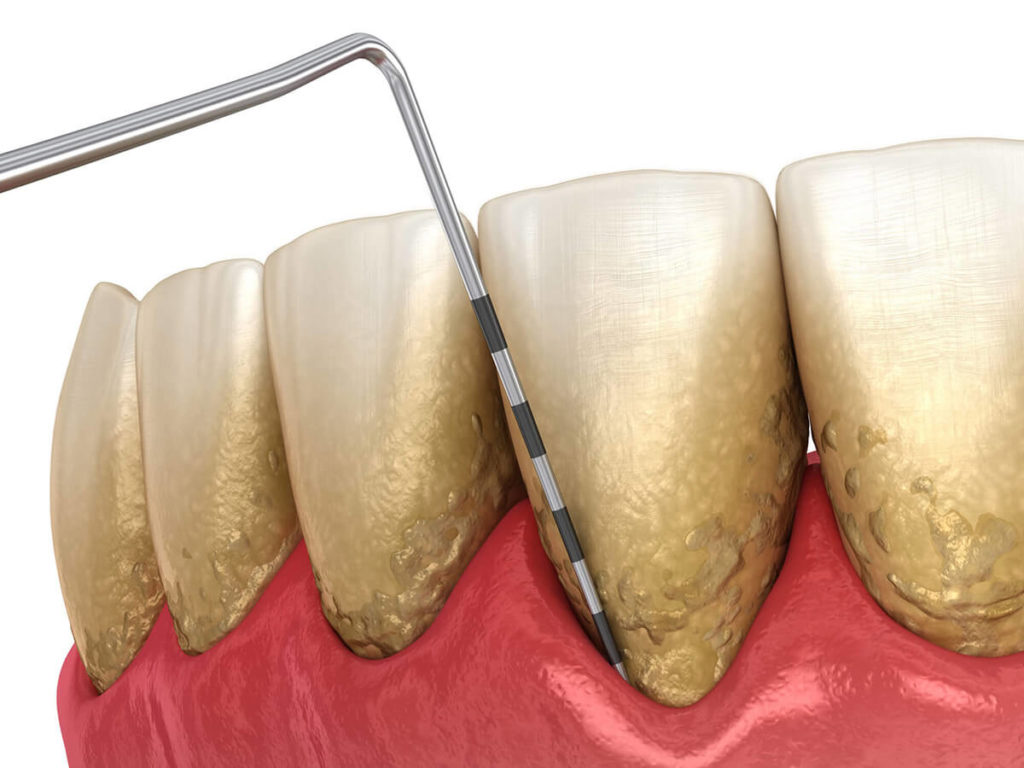Periodontal Disease Treatment (Gum Disease)
Gum disease is a serious condition that affects people from all walks of life. Our dental office provides periodontal services for all stages of gum disease to restore your oral health.
Gum Disease
Periodontal disease, periodontitis, and gum disease are all phrases used to describe an infection in the gums and bone surrounding your teeth. Healthy bone and gum structures help keep a tooth’s root intact. When food and plaque get trapped between the gums and teeth, it can lead to infection, resulting in gum disease. Periodontal disease is a very serious dental disease that affects many people. It is caused by bacteria from plaque formations on the teeth.
Gingivitis is an inflammation of the gums and one of the earliest stages of gum disease. Common symptoms of gingivitis include minor redness, swelling, or light bleeding of the gums. If left untreated, gingivitis turns into a more serious infection known as periodontal disease, which can lead to permanent structural damage.
Nearly half of all adults suffer from periodontitis to some extent—periodontitis is also referred to as gum disease and occurs when the gums are left exposed to harmful bacteria, tartar and plaque for an extended period of time. This can be caused by poor flossing habits and build-up between the teeth. If left untreated, it can progress and lead to bone and tooth loss.

-
What are the signs of periodontal disease or gum disease?
The earliest sign of periodontitis is an irritated gum line that might present some discomfort or bleeding when you brush, floss or have your teeth cleaned professionally. If not treated, the gums will start to retract and pull away from the teeth. This creates spaces between the teeth and gums called periodontal pockets that can quickly become filled with harmful accumulations. Your dentist will typically measure the depths of these pockets to determine how far the condition has spread and what treatment is needed to correct the problem. If gum disease eventually makes its way down to the jawbone and the connective tissues of teeth, the jawbone can deteriorate, and teeth can be lost.
-
What causes periodontal disease or gum disease?
Our mouths provide a home to millions of bacteria, both beneficial and harmful. Bacteria form a sticky substance, plaque, that adheres to the teeth. Brushing and flossing aim at removing plaque before it mineralizes into tartar. Tartar becomes a colony for more bacteria and adds to their population, pumping out toxins into the gums.
Gums react to this bacterial invasion with an inflammatory response under the direction of the immune system. Around the base of each tooth, a small collar of gum tissue exists that forms a small crevice or pocket. This warm, dark environment provides a perfect habitat for deeper tartar and bacterial penetration, with their toxins seeping into the base of the collar.
Early inflammation results in bleeding gums, known as gingivitis. Bacteria left untreated and undisturbed successfully create a chronic infection in the gum collar. In many cases, the bone begins to deteriorate around the teeth as the bacteria burrow deeper into the gums. While gums may be slightly tender at this stage, there’s generally minimal discomfort as the bone dissolves.
More than 50% of the bone around your teeth can disappear before any signs of looseness or pain begin to appear. The bone around teeth never regenerates, so this loss becomes permanent and harder to control as the bacteria hide deeper into the gums. Untreated gum disease leads to abscess and generalized tooth loss in many advanced cases.
-
How is periodontal disease or gum disease treated?
Periodontal disease, or gum disease, is effectively treated in two ways, which treatment you receive depends on the severity of the gum disease.
Scaling and root planing are recognized as the standard treatment for periodontitis. The procedure is highly effective in managing the condition in its early to moderate stages. It also does an excellent job of reversing its harmful effects. When providing scaling and root planing treatment, your dentist will access the areas below the gum line and between the teeth and remove harmful accumulations of plaque, tartar and oral bacteria. Then the root surfaces will be smoothed out to prevent future accumulations. Your gums should then begin the healing process and eventually reattach themselves to the teeth.
The second treatment is called bone grafting and is often required when bacteria and plaque have reached the jawbone and caused some amount of deterioration and decay. Your dentist must surgically access the damaged jawbone in order to regenerate it. This is accomplished by applying proteins and artificial bone-like material to the areas of decay. This will help encourage new bone growth. Bone grafting is often a necessary step for strengthening the jawbone so that it can support dental implants to replace missing teeth.
Questions About Gum Disease?
If you have any questions about periodontal disease treatment or if you are concerned that you have gum disease, contact us or request an appointment today. We also provide a variety of other preventative, restorative, and cosmetic dental services. What do you want to do next?


